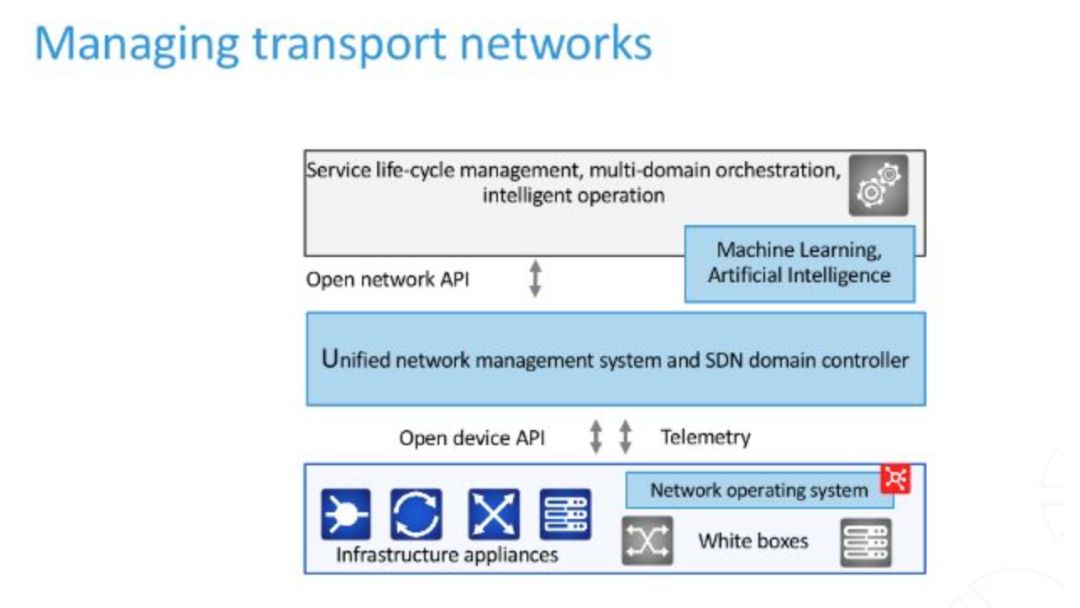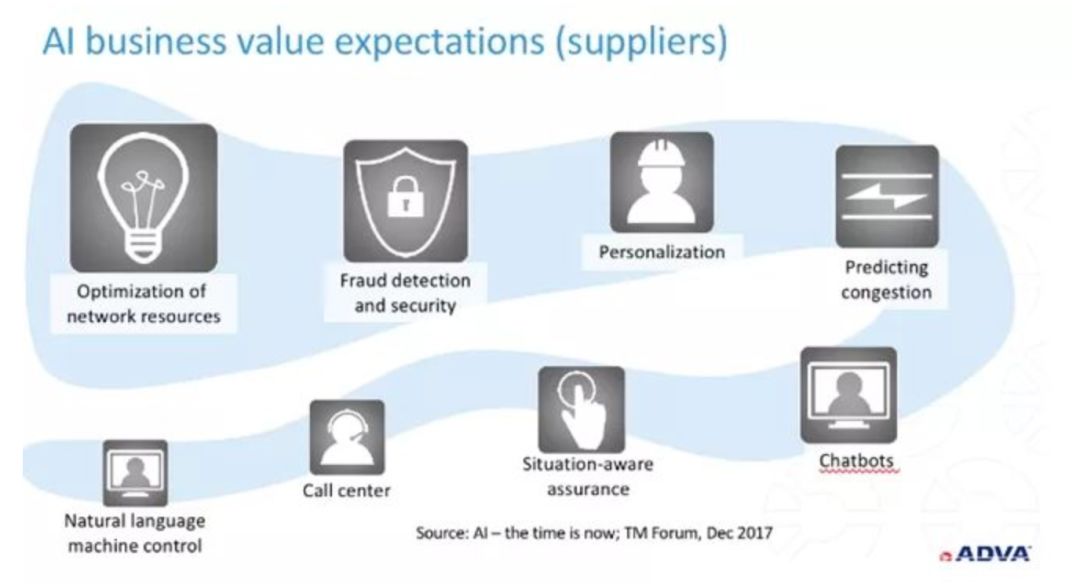How to realize SDN through machine learning and artificial intelligence?
The status quo of SDN in the eyes of service providers
With its advantages in network simplification and new revenue streams, software-defined networking has undoubtedly aroused strong interest from service providers. The core of this technology is to separate the physical network function from the software control and create an ecosystem of open switches and control software to realize a new environment of rapid innovation and easy integration.
The open community has invested a lot of effort in defining interfaces and protocols for program control. The combination of open protocols and open source controllers has been proven in many displays, highlighting the advantages of resource abstraction and control in multi-vendor and multi-operator networks. However, although this technology is currently widely used in data centers, due to the business challenges of service provider networks, there are still very few real-time networks using SDN technology.
Although standardized and stable interfaces are indeed necessary prerequisites for the widespread adoption of SDN, service providers need a positive business case to shift from manual control to automated network control. Currently, the additional work required to integrate and maintain the new interface and additional central control instances seem to offset the cost advantage of automation.
A broader view of SDN
In order to understand the full potential of SDN, we need to shift the focus from automation to automated operations. To fully understand the network status, available resources and service requirements, intelligent algorithms are worth recommending. The closed-loop control is initially activated by human control. Through the open SDN interface, the closed-loop control will be developed in the process of network programming.

SDN is a key enabler for the realization of advanced operating methods based on ML and AI. Simplifying the control of the underlying network should be the first step in implementing autonomous network routing. Ignoring this point will bring huge losses, as Bill Gates emphasized: "The first rule of any technology used by enterprises is that applying automation to high-efficiency operations will increase efficiency. Secondly, applying automation to low-efficiency The operation will reduce efficiency. "If there is no model-based hierarchical network abstraction, the simplification of network operations cannot be successful.
The power of ML and AI
There is a lot of evidence that proves the power of deep learning and (narrowly) artificial intelligence. When Google's DeepMind's AlphaGo defeated the best Go players, the expert community was puzzled by this unprecedented way of playing. In terms of diagnosis and treatment, IBM Watson has always performed better than cancer experts. Obviously, artificial intelligence can compete with humans in terms of speed and efficiency in the case of a high degree of complexity and a large amount of diverse information.
Cases like this make service providers have high expectations for AI, and they want AI to play a role in network costs and operations. The figure below shows the results of the TMF survey at the end of last year (TMF trend analysis: AI-current time; December 2017). Vendors were asked about the most relevant use cases.
AI also hopes to be applied to WAN security. Various complex attack patterns and zero-day attacks are obviously an interesting application of artificial intelligence. But the area with the highest expectations is network optimization.

Suppliers have high hopes for improving their business, mainly to improve the efficiency of resource utilization. As mentioned above, operations should be based on a simplified and streamlined network. SDN with open control and hierarchical abstraction is the most promising way to achieve this premise. More importantly, there should be a mechanism to quickly capture any useful data from the network and its operations. Model-based telemetry streaming is considered the preferred method to efficiently collect the required data from a decentralized network.
Example
The introduction of artificial intelligence into our network is a major move. It affects network technology, but it also affects operational processes in a destructive way. It is a wise choice to solve the problems of the clearly defined application domains in a targeted manner. In this way, not only can experience be gained, but also the improved methods of the network can be stably applied to the operation and consistent with the underlying network architecture. Two practical examples are outlined below and the relevance of SDN is emphasized.
Predictive maintenance
Service providers often define specific thresholds for triggering repair processes or network extensions. Today, decisions are often based on a single data point, such as a resource utilization threshold or bit error rate. But this method ignores a lot of useful information. On the other hand, predictive maintenance provides a comprehensive understanding of the characteristics of the network and its applied components. And this predictive maintenance can generate warnings before downtime caused by failures. .
ADVA's network operations center uses this method to manage the networks of multiple customers. The data in the network is continuously captured, and then the neural network method is used to analyze the data, so the faulty components can be identified before the network failure occurs. Combining AI with automatic flow control allows service providers to preemptively detect affected interfaces/components and repair them with zero downtime, even for non-redundant parts of the network. This opens up new ways of designing and operating networks in a more cost-effective manner.

Network optimization in photonic network
Designing an optical layer requires a highly skilled photon transmission expert who needs knowledge of multi-level modulation, fiber dispersion and nonlinearity, and the transient characteristics of the amplification optical system. If a new wavelength must be activated, complex software tools need to be applied to calculate performance. This complicates automatic wavelength routing in large optical systems.
Machine learning has opened up new ways to solve this problem. Instead of numerical calculations, system behavior is estimated by neural algorithms trained on real data collected from a large number of networks. Facts have proved that this method is completely accurate in predicting the signal performance in the photonic network, and combined with automatic SDN control, it builds the basis for autonomous operation.
The figure below shows the comparison between the signal performance predicted by the smart algorithm and the actual network data. With the continuous increase of data sets, this method has reached an accuracy suitable for real-time network deployment.

We are still in the early stages of applying AI and ML to network planning, design and operation. Use cases such as predictive maintenance or network optimization provide hope for reducing network costs. SDN is a key prerequisite for closed-loop automation.
Aurora Disposable Vape Device Vaping Pod Systems
Shenzhen WeiKa Technology Co.,Ltd. is a professional e-cigarette manufacturer and enterprise integrating R&D, design, production and sales and service of the electronic cigarette atomizer products, established in 2020.
We are actively developing and producing all kinds of reliable and unique atomizer products. We centre on research, developing, high quality and safety, and focus on better vaping experience in all aspects to our customers. We have advanced production equipment and strict production control system, each process has strict management, from production to delivery have been strictly tested to ensure the classic quality. Zgarvape for the future!
Aurora E-cigarette Cartridge is loved by the majority of consumers for its gorgeous and changeable colors, especially at night or in the dark. Fruits Flavors series, plant flavors series & special flavors series.Up to 16 different flavors for choices. A new design of gradient our disposable vape is impressive. Our vape pen and pods are matched with all the brands on the market. You can use other brand's vape pen with our vape pods. Aurora series Pods systems, the first choice for professional users!
16 Available Flavors (3Pods*2ml):
Amazing Cantaloupe / Coke on the Rocks / Ice Coconut / Ice Lolly / Iced Mung Bean / Longjing Tea / Mango Feast / Mountain Spring / Peach Tempting / Pineapple Juice / Refreshing Melon / Refreshing Mint / Rich Strawberry / Rose Litchi / The Ocean / Watermelon Juice





Aurora Pods 1.0,ZGAR Aurora Vape Pods 1.0 Pod System Vape,ZGAR Aurora Vape Pods 1.0 Pos Systems Touch Screen,ZGAR Aurora Pods 1.0 Disposable Vape Pod System,400Puffs Pod Vape System
Zgar International (M) SDN BHD , https://www.zgarecigarette.com